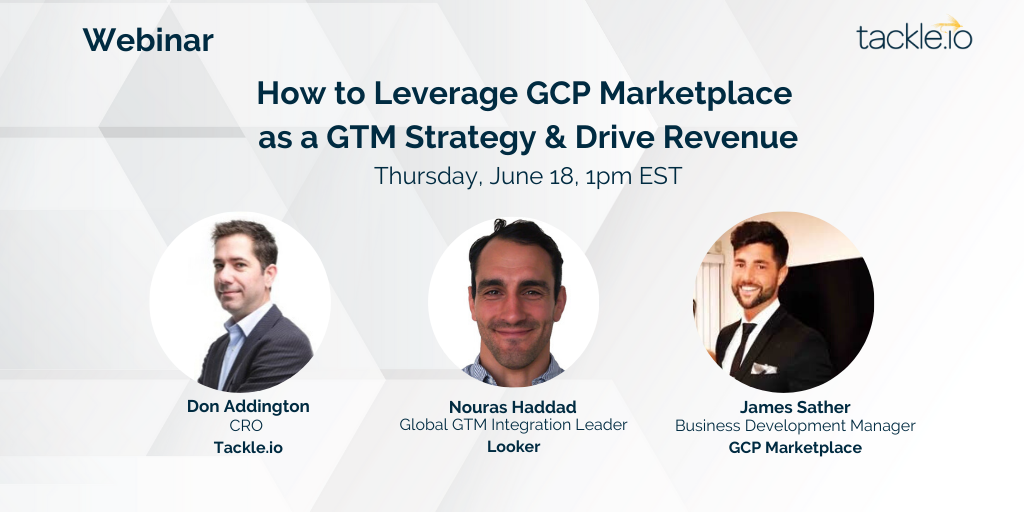
You’ve invested hours getting a buyer ready to purchase your software, and then they run into an issue with their budget. Or they have to play a match of contract tennis, bouncing between you and their legal team. Or they’re interested but feel that adding another tool to their stack is too large of a commitment.
There are many potential roadblocks to direct software purchases, as sales teams are all too familiar with. The process isn’t much easier for the buyer, either. 77% of B2B buyers agree that purchases have become very difficult, which doesn’t exactly get the vendor-client relationship off on the right foot.
What’s to be done, then? Cloud Marketplaces, like Google Cloud Platform (GCP), are an appealing solution for a growing number of software sellers. Tapping into existing commitments can mean accelerated time to revenue and easier sales. Quite simply, you can make the lives of your sales team and your buyers easier by meeting customers where their wallets already are.
While interest in (and use of) Marketplace (MP) for selling software is growing, it can still feel like uncharted territory for many. Looking for a tour guide through the wonderful world of Marketplace sales? You’ve come to the right place.
In our webinar, How to Leverage GCP Marketplace as a GTM Strategy & Drive Revenue, we talked to three experts about using Google Cloud Platform in your selling strategy. Don Addington of Tackle, Nouras Haddad of Looker, and James Sather of GCP Marketplace shared their experience and insights on:
- Looker’s journey to GCP Marketplace and their tips for success
- Benefits of GCP Marketplace to sellers and the best deals to run through MP
- How to accelerate the Marketplace buying process
Here’s what they shared:
Looker is a data analytics platform that helps businesses finish “the last mile” of reporting with dashboards, charts, and reports. In Nouras Haddad’s role as Looker’s Global Go-To-Market Integration leader, he’s had a front-row seat to the company’s partnership with Google Cloud Platform Marketplace.
What drew Looker to add a Cloud Marketplace as an additional sales channel? One of the reasons is that “at Looker, we kind of aim to generate anywhere from 15%-25% of Looker’s new business by partners, whether they are technology partners like Google Cloud or consulting partners.”
Partnerships and co-selling expand your reach
The most recent channel they’ve added is GCP Marketplace, where they’ve found enthusiastic support from Cloud reps. James Sather, Business Development Manager at GCP Marketplace, echoed the excitement about MP reps jumping into the ring and helping ISVs.
“From a policy perspective, Google Cloud compensates our sales reps on third-party MP solutions at 100% of the total contract value that flows through the Marketplace. So as you can imagine, sales reps who get to retire third-parties as if it’s just a first-party Google service get pretty amped up and jazzed up to work with you all.”
James also noted that “We have a 34-page slide deck of all the various benefits and programs that we offer, from the ability to issue credits yourself to new customers, issuing press releases, or even AdWords campaigns. So we give you all the tools necessary to be successful.”
Luckily for MP reps, and the ISVs that hope to work with them, selling is a truly joint effort. MP reps become an extension of your sales team that can help connect the dots between you and potential customers.
“The ISV can focus on actually selling their product. That way, [GCP] reps don’t feel like they need to learn a third-party product completely. They can bring them [ISVs] into the discussions, and it just becomes all about executing for the end-customer and making the transaction as seamless as possible through the Marketplace,” James continued.
Don Addington, CRO at Tackle, added that “This is a strategic relationship. Often, [you have to create] your own billboards of success and go back to a rep and say, “Hey, we sold this deal in this account. You got paid on it. Let us tell you a little more about why we won, what that was, and what happened.” Taking real control of that. Invariably, whenever we win a deal at Tackle, we always go back to the different hands involved.”
Consolidated billing and pre-existing commitments accelerate deals
On top of all the support ISVs receive from MP reps, completing deals via Marketplace is often easier for buyers, leading to shorter buying cycles. As opposed to negotiating with enterprise buyers over adding your business as a new vendor, you can add your service as merely another line item on their Google Cloud bill.
“It’s consolidated billing.” Nouras said. “They don’t have to add Looker as a vendor in their system, which has helped us with a lot of enterprise customers, frankly, because when you’re talking to some massive names out there, adding another vendor into the procurement cycle can sometimes take three to six months easily.”
Don added that “Marketplace can be great to do the smaller first deal fast,” and then expand your relationship at renewal time.
Since MP buyers already have Cloud Provider agreements in place, “the deal is going to go faster than if you had to go in the front door, get at it as a vendor, go through protracted negotiations around contracts.”
Another element of selling via Marketplaces that accelerates deals are your buyer’s pre-existing commitments. When there’s already a set amount of spending they need to use with a Cloud Provider within a period of time, you can use this budget as leverage for your own deals. Plus, your buyer ensures they use what they’ve paid for. Everybody wins!
Nouras noted that “customers will have credits with Google or with AWS or with Azure that they want to burn since they’ve already prepaid for them. So they can just pay for third-party software with those credits.”
“For us, it’s moved the needle on a number of deals. Honestly, it’s more than I would expect because if a customer’s getting a 15% discount on their commitment, there’s a dollar value associated with that commit. They need to make sure it goes against the commitment.” Nouras shared.
Being available on your buyer’s preferred Cloud Marketplace can even be a competitive advantage.
Nouras noted that “if you’re in the Marketplace and your solution can draw down on their commitment and your competitors can’t, that can make the difference on that deal, sometimes more than what you’re selling.”
Educating and incentivizing your sales team empowers them to lean into Marketplaces
As wonderful as MPs are for accelerating deals and finding new audiences, it’s not a “build it, and they will come” situation.
Don noted that “Point-click and easy deploy can happen, but largely we find the customers that are doing significant revenue through the channel aren’t necessarily doing massive volume, they’re doing pretty big deals.
“[Sales teams have to take it] upon yourself to understand this as a channel and understand the Marketplace and how to message it. Because especially early days, in our experience, the business does not generally walk up and knock on your door.”
One way to ensure you’ve equipped your sales team with the resources they need is to educate them on what’s available. James reminded us to ”make sure that you’re spending time on educating yourself on everything that the Marketplaces have to offer and then aligning your sales team with that.”
On top of education for your sales team, consider making MP deals comp neutral.
“Channels don’t work when it’s, “Hey, this one costs me more than that one.” We know where the sales team’s going; they’re going to the one that costs the least. So it’s something that we strongly advise our customers on and that we see a direct correlation to faster success in the Marketplace when you make that comp neutral.” Don explained.
Alliance leads and leadership buy-in are crucial
Other crucial elements to ensuring Marketplace success include leadership buy-in and MP Alliance leads. Don shared that at Tackle, “we have an Alliance lead for each one of the Marketplaces. And this role is critical.”
Don continued, “It’s a pretty common pattern for Alliance managers to focus on understanding how the Cloud Providers work and then leveraging that both from a product and customer-facing perspective, and internally with your sellers.”
Another best practice that Nouras shared is getting your entire company on board with your new sales channel. “I think it’s vital, just like any channel or any project you’re spinning up, to make sure you have buy-in from your own sales leadership. It needs to fit into the overall go-to-market of your company.”
You may need to shift your KPI focus
We’ve explored the topic of Marketplace KPIs previously, and Don pointed out that you shouldn’t necessarily focus on the number of deals at first.
“Some of the things that people don’t think about are faster deals. Maybe you’re not looking for customer acquisition as the main thing that you communicate to your executive team [in year one]. But a faster deal when you compare a MP deal versus a direct deal, you can show moving the needle on that or fewer hands touching that deal.”
Cloud Marketplaces like the Google Cloud Platform can help you accelerate your deals by meeting buyers where they’re already committed to spending. Plus, you gain new sales partners as you build relationships with Marketplace reps.


